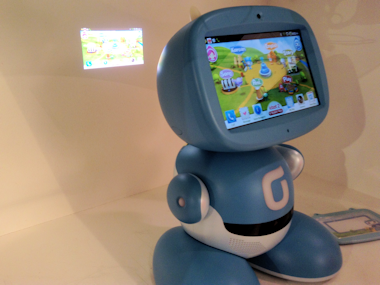If you attend a tech trade show and don’t leave time to wander the show floor, you are really missing out.

Sure, there are juggling clowns that can’t juggle, dime-a-dozen phones, and booths touting the beauty of backhaul. But the massive show floor is also home to hidden gems and tons of quirktastic geekiness.
Perusing the booths in Barcelona, I saw all manner of phones, tablets and phablets, along with something called Motorheadphones â€" headphones that promised “everything louder than everything else.â€
“No weak-kneed, lily-livered tin-pot and skinny sounding little pieces of garbage,†Motorheadphones (named for “the world’s loudest band,†Motorhead) promised in its marketing materials.
There were rival robots from Korean telecom operators SK and KT, both aimed at children. KT’s robot is the second version of its Kibot, and sells for around $ 500 or for free in Korea with a $ 20-a-month connectivity plan.
The latest Kibot, aimed at kids from 3 to 13, adds a rear projector and a voice recorder. It can teach things from basic sensory understanding through phonics and foreign languages. The device responds to touch â€" a brief petting, and the robot’s electronic eyes light up.
SK’s Kids Learning Robot is aimed at 4-to-6-year-olds and is still in the final development stages. At around $ 300, it’s considerably cheaper, using one’s own Android device to provide both the robot’s screen and connectivity. (Support for iPhone is aimed for later this year.)
Each part of the robot’s body contains sensors for interacting with little ones. The robot’s eyes have proximity sensors, the cheeks contain LEDs for expressing emotion, and the forehead has touch sensors.
A wireless Bluetooth wand can be used to interact via gestures.
But some of the coolest stuff was hidden behind closed doors in Hall 2. There, in meeting rooms, companies showed off technology not yet ready to be put on public view.
Samsung’s component arms, for example, were said to be showing some new flexible displays. I politely asked at the door if I could have a little peek, and was equally politely, but emphatically, denied.
Hall 2 was also home to lots of deal-making. Verizon Wireless, for example, had folks at the show meeting to hammer out various international roaming agreements. The company hopes to offer 4G LTE roaming by next year in several countries, including Canada.
Even without such access, there was plenty to be seen in the acres of booths that span the length of the new convention center on the outskirts of Barcelona. (Until this year, the show was held in an older venue in the heart of the city.)
Dedicated areas focused on everything from payments to digital health, and there were also the ubiquitous national pavilions, where countries would group together various local companies.
Austria, Canada, China, Egypt, Germany, Greece, Hungary, Israel, Korea, Norway, Scotland, Sweden and Tunisia were among those represented, along with host country Spain.
Other stops included a visit with Yota Devices, the Russian company aiming to market a dual-screen Android device that has an E-ink screen that can be used to store handy information such as a local map or a boarding pass.
Yota hopes to bring out its first Yota Phones in the fourth quarter of this year, including in North America. The goal is to have the device cost no more than a typical premium Android device with similar specifications.
The hardware maker, spun out of a Russian carrier of the same name, has been making modems and routers, but decided to enter the phone business with its idea for the dual-screen device.
CEO Vladislav Martynov says the company filed for patents some time ago, but expects copycats nonetheless.
“I’m sure everyone will jump on it if we are successful,†Martynov said.
RELATED POSTS:
No comments:
Post a Comment